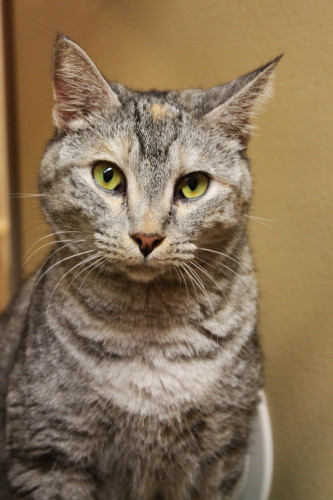Feline Asthma and Bronchitis
Just like human asthma, feline asthma is a chronic inflammation of
the small passageways of a cat's lungs, which often develops another breathing
problem called allergic bronchitis. The airways in the cat's lungs get inflamed,
the result of an allergic reaction to inhaled germs, dust, smoke, and other
irritants. Feline bronchial disease isn't contagious.
Many cat owners mistaken this condition with hairball attack, or
possibly chocking on a bit of food. Here we will share the most common
symptoms, causes, treatments, and condition management. Please note, if your
cat is experiencing an extreme respiratory distress, contact your veterinary immediately.
What are the Symptoms of Feline Asthma?
Asthma can affect cats of all ages, and symptoms may be hard to detect. It can start as simple as a faint wheezing, which can be noticeable after exercising, and develop into a serious asthma attack.
The most common symptom is coughing, which at first may resemble a cat trying to cough up a hairball, or possible choking on food. While having an asthmatic attack the cat will squat with its shoulders hunched up and neck extended. In addition to coughing, the cat will gag up a foamy, mucus like substance, and then swallowing it hard.
YouTube by: reesmd101
Severe
asthma attacks can be life-threatening. A cat in a full-blown attack should be
taken to a veterinarian right away. Do
not try to give mouth-to-mouth resuscitation or CPR to a cat having an asthma
attack.
Please note, a severe asthma attack can be fatal!
Other
diseases share many of the same symptoms as feline asthma, such as heartworm (associated respiratory disease). Your veterinarian will perform the proper test
to determine the correct diagnostic and treatment.
What Environmental Factors Can Trigger an Asthma Attack in Cats?
There are several allergens that can trigger an asthma attack in cats, and many of them are the same allergens responsible for human asthma attacks.
- Smoke - In addition to tobacco smoke, burning candles and wood-burning fireplaces smoke can also trigger asthma.
- Household Products - Vapors from household solutions and sprays (aerosols) aggravate asthma symptoms and can also bring on an attack. You many consider replacing some of them with less offensive cleaning products - "green products." Click here to learn more about harmful substances.

- Pollen - Cats may show symptoms of asthma during spring, summer, and fall. During these months pollen from trees, flowers, weeds, and grasses can cause asthma attacks. If possible, limit your cats exposure to pollen by keeping him/her indoors.
- Mold and Mildew
- Dust and Dust Mites
- Food - Most cats may show signs of food allergies by developing some form of skin or gastrointestinal illness. However, food can also trigger feline asthma. Wheat, gluten, milk, fish, tuna, and preservatives that are added to cat foods are among the top asthma triggers.
- Cat Litter - Heavy scented, dusty, and clay litter can also cause asthma.
- Stress - Cats are animals that like routine, where changes on their environment can induce stress, which will make allergies and asthma worse.
In addition to environmental factors,
asthma in cats can also be caused by a pre-existing condition, parasites and
obesity.
How Feline Asthma is Diagnosed?

Your veterinarian can perform different tests in order to diagnose feline asthma. Common diagnostic procedures are:
Chest X-Ray - This is probably the first test your veterinarian will perform. He/she will look for irregularities, such as: inflammation around the airways in the lungs; a flat looking diaphragm; and/or a partial collapse of the lung. If your vet finds any evidence of heart disease, he/she will send the X-Ray to a specialist for consultation.
Blood Tests - Blood work is also performed to detect signs of infection, which often go along with asthmatic bronchitis.
Bronchoalveolar Lavage (BAL) - This is procedure is performed by
inserting an endotracheal tube into the trachea, where fluids presented in the
airways of the lungs are extracted for examination.
Asthma Treatments and Management.
YouTube by: MercolaHealthyPets
Your veterinarian will determine which treatment will be most effective on treating your cat. Treatments may include:
- Steroid such as prednisone, has a beneficial effect on decreasing inflammation, dilating the airway, and decreasing mucus production.
- Aerosol corticosteroid is the most effective therapy for cats with asthma. This treatment is delivered by metered dose inhalers (MDI) - Aerokat Feline Aerosol Chamber.
- Additionally, long-acting repository corticosteroid injections can be used as an alternative to pills and aerosol therapy.
- Bronchodilators are used to open up the airway, allowing the cat to breath more freely. The most commonly-prescribed bronchodialator is Albuterol, which can also be administered through a feline aerosol container, such as Aerokat.
Feline asthma can vary from cat to cat, so make sure you work with your veterinarian to ensure your cat gets the best possible treatment.
Returning from Feline Asthma to Our Home Page
Healthy Cat Treat

Subscribe to Our Love Cats Digest e-zine
"A cat improves the garden wall in sunshine, and the hearth in foul weather." - Judith Merkle Riley
Marketing Strategies by









New! Comments
Have your say about what you just read! Leave me a comment in the box below.